Attached files
| file | filename |
|---|---|
| 8-K - FORM 8-K - PEABODY ENERGY CORP | c54578e8vk.htm |
Exhibit
99.1
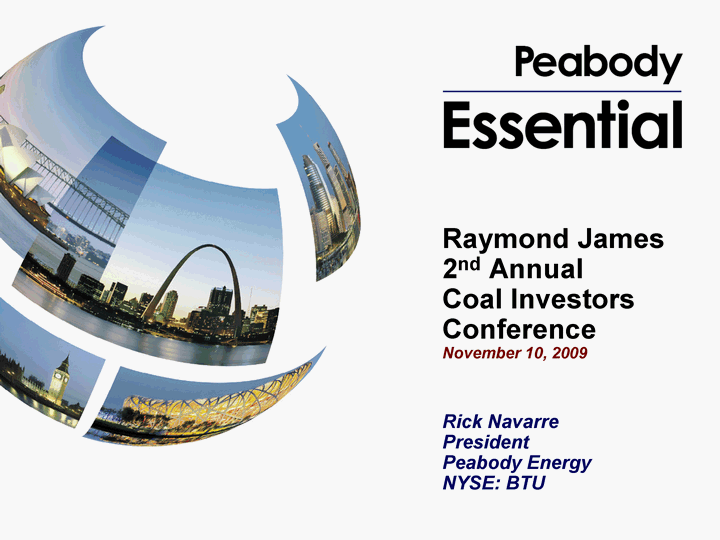
| Raymond James 2nd Annual Coal Investors Conference November 10, 2009 Rick Navarre President Peabody Energy NYSE: BTU |
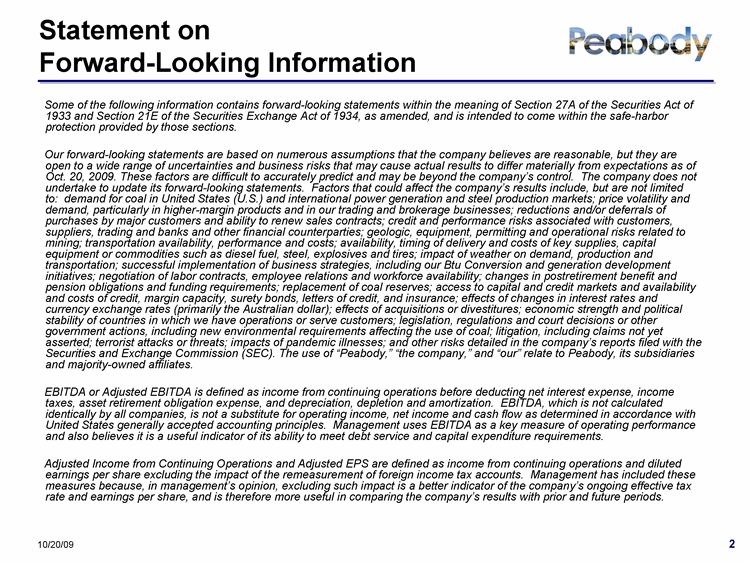
| Statement on Forward-Looking Information Some of the following information contains forward-looking statements within the meaning of Section 27A of the Securities Act of 1933 and Section 21E of the Securities Exchange Act of 1934, as amended, and is intended to come within the safe-harbor protection provided by those sections. Our forward-looking statements are based on numerous assumptions that the company believes are reasonable, but they are open to a wide range of uncertainties and business risks that may cause actual results to differ materially from expectations as of Oct. 20, 2009. These factors are difficult to accurately predict and may be beyond the company's control. The company does not undertake to update its forward-looking statements. Factors that could affect the company's results include, but are not limited to: demand for coal in United States (U.S.) and international power generation and steel production markets; price volatility and demand, particularly in higher-margin products and in our trading and brokerage businesses; reductions and/or deferrals of purchases by major customers and ability to renew sales contracts; credit and performance risks associated with customers, suppliers, trading and banks and other financial counterparties; geologic, equipment, permitting and operational risks related to mining; transportation availability, performance and costs; availability, timing of delivery and costs of key supplies, capital equipment or commodities such as diesel fuel, steel, explosives and tires; impact of weather on demand, production and transportation; successful implementation of business strategies, including our Btu Conversion and generation development initiatives; negotiation of labor contracts, employee relations and workforce availability; changes in postretirement benefit and pension obligations and funding requirements; replacement of coal reserves; access to capital and credit markets and availability and costs of credit, margin capacity, surety bonds, letters of credit, and insurance; effects of changes in interest rates and currency exchange rates (primarily the Australian dollar); effects of acquisitions or divestitures; economic strength and political stability of countries in which we have operations or serve customers; legislation, regulations and court decisions or other government actions, including new environmental requirements affecting the use of coal; litigation, including claims not yet asserted; terrorist attacks or threats; impacts of pandemic illnesses; and other risks detailed in the company's reports filed with the Securities and Exchange Commission (SEC). The use of "Peabody," "the company," and "our" relate to Peabody, its subsidiaries and majority-owned affiliates. EBITDA or Adjusted EBITDA is defined as income from continuing operations before deducting net interest expense, income taxes, asset retirement obligation expense, and depreciation, depletion and amortization. EBITDA, which is not calculated identically by all companies, is not a substitute for operating income, net income and cash flow as determined in accordance with United States generally accepted accounting principles. Management uses EBITDA as a key measure of operating performance and also believes it is a useful indicator of its ability to meet debt service and capital expenditure requirements. Adjusted Income from Continuing Operations and Adjusted EPS are defined as income from continuing operations and diluted earnings per share excluding the impact of the remeasurement of foreign income tax accounts. Management has included these measures because, in management's opinion, excluding such impact is a better indicator of the company's ongoing effective tax rate and earnings per share, and is therefore more useful in comparing the company's results with prior and future periods. 10/20/09 |
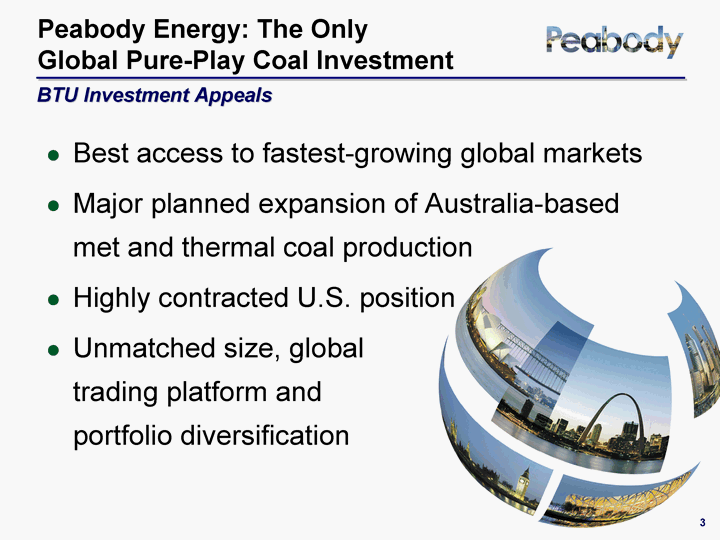
| Peabody Energy: The Only Global Pure-Play Coal Investment Best access to fastest-growing global markets Major planned expansion of Australia-based met and thermal coal production Highly contracted U.S. position Unmatched size, global trading platform and portfolio diversification BTU Investment Appeals |
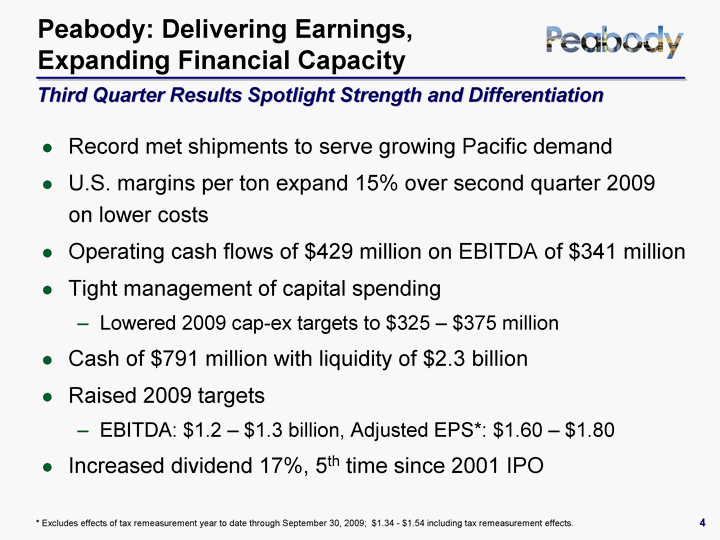
| Peabody: Delivering Earnings, Expanding Financial Capacity Record met shipments to serve growing Pacific demand U.S. margins per ton expand 15% over second quarter 2009 on lower costs Operating cash flows of $429 million on EBITDA of $341 million Tight management of capital spending Lowered 2009 cap-ex targets to $325 - $375 million Cash of $791 million with liquidity of $2.3 billion Raised 2009 targets EBITDA: $1.2 - $1.3 billion, Adjusted EPS*: $1.60 - $1.80 Increased dividend 17%, 5th time since 2001 IPO Third Quarter Results Spotlight Strength and Differentiation * Excludes effects of tax remeasurement year to date through September 30, 2009; $1.34 - $1.54 including tax remeasurement effects. |
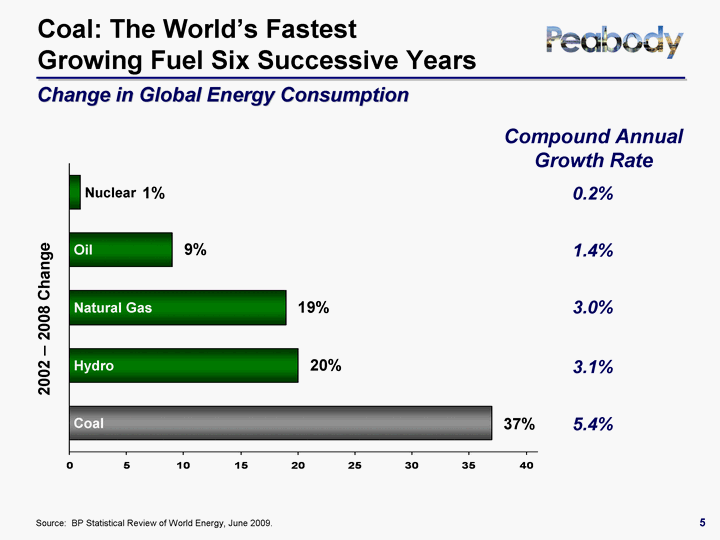
| Compound Annual Growth Rate Coal: The World's Fastest Growing Fuel Six Successive Years Change in Global Energy Consumption Source: BP Statistical Review of World Energy, June 2009. Coal Hydro Natural Gas Oil Nuclear 2002-2008 37 20 19 9 1 37% 2002 - 2008 Change 20% 9% 19% 1% Coal Natural Gas Oil Hydro 0.2% 1.4% 3.0% 3.1% 5.4% Nuclear |
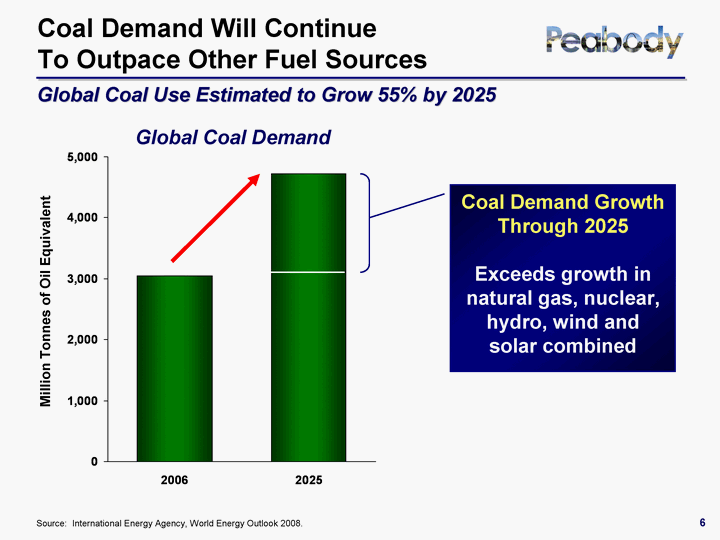
| Coal Demand Will Continue To Outpace Other Fuel Sources 2006 2025 Coal 3053 4719 Million Tonnes of Oil Equivalent Source: International Energy Agency, World Energy Outlook 2008. Global Coal Demand Global Coal Use Estimated to Grow 55% by 2025 |
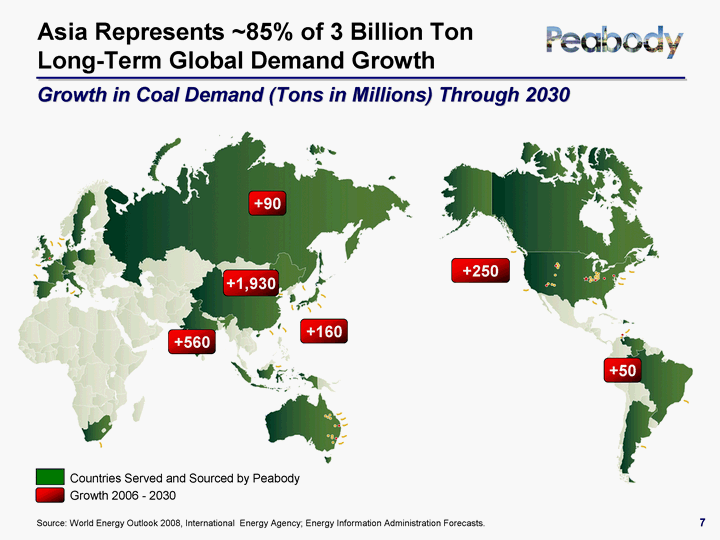
| 7 Source: World Energy Outlook 2008, International Energy Agency; Energy Information Administration Forecasts. Asia Represents ~85% of 3 Billion Ton Long-Term Global Demand Growth Growth in Coal Demand (Tons in Millions) Through 2030 +560 +1,930 +250 +50 +90 +160 Countries Served and Sourced by Peabody Growth 2006 - 2030 |
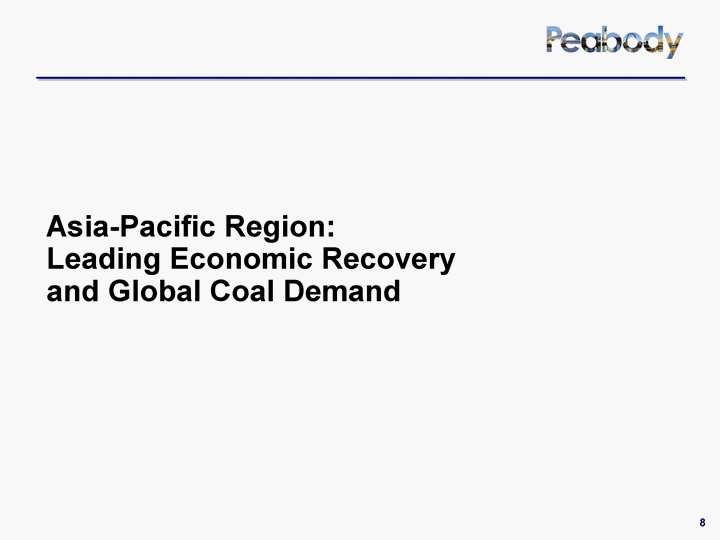
| Asia-Pacific Region: Leading Economic Recovery and Global Coal Demand |
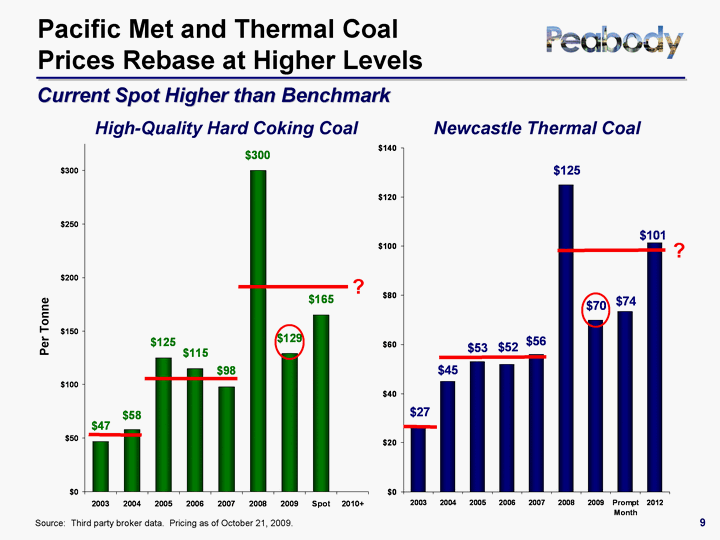
| 2003 2004 2005 2006 2007 2008 2009 Prompt Month 2012 27 45 53 52 56 125 70 73.56 101.31 Newcastle Thermal Coal Source: Third party broker data. Pricing as of October 21, 2009. 2003 2004 2005 2006 2007 2008 2009 Spot 2010+ 47 58 125 115 98 300 129 165 High-Quality Hard Coking Coal Current Spot Higher than Benchmark ? ? Per Tonne Pacific Met and Thermal Coal Prices Rebase at Higher Levels |
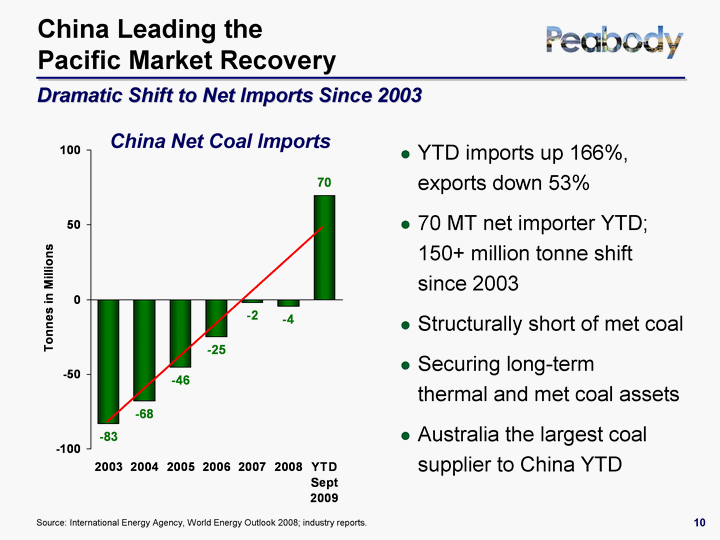
| 2003 2004 2005 2006 2007 2008 YTD Sept 2009 Imports -83.124 -67.963 -45.548 -24.988 -2.087 -4.449 69.557 China Leading the Pacific Market Recovery YTD imports up 166%, exports down 53% 70 MT net importer YTD; 150+ million tonne shift since 2003 Structurally short of met coal Securing long-term thermal and met coal assets Australia the largest coal supplier to China YTD Dramatic Shift to Net Imports Since 2003 Source: International Energy Agency, World Energy Outlook 2008; industry reports. China Net Coal Imports |
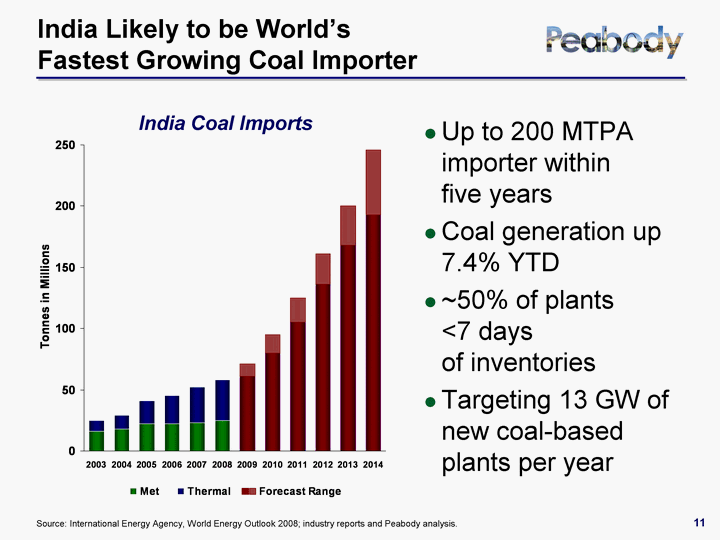
| India Likely to be World's Fastest Growing Coal Importer Source: International Energy Agency, World Energy Outlook 2008; industry reports and Peabody analysis. Up to 200 MTPA importer within five years Coal generation up 7.4% YTD ~50% of plants <7 days of inventories Targeting 13 GW of new coal-based plants per year 2003 2004 2005 2006 2007 2008 2009 2010 2011 2012 2013 2014 Met 16 18 22 22 23 25 Thermal 9 11 19 23 29 33 61 80 105 136 168 193 Forecast Range 10 15 20 25 32 53 India Coal Imports |
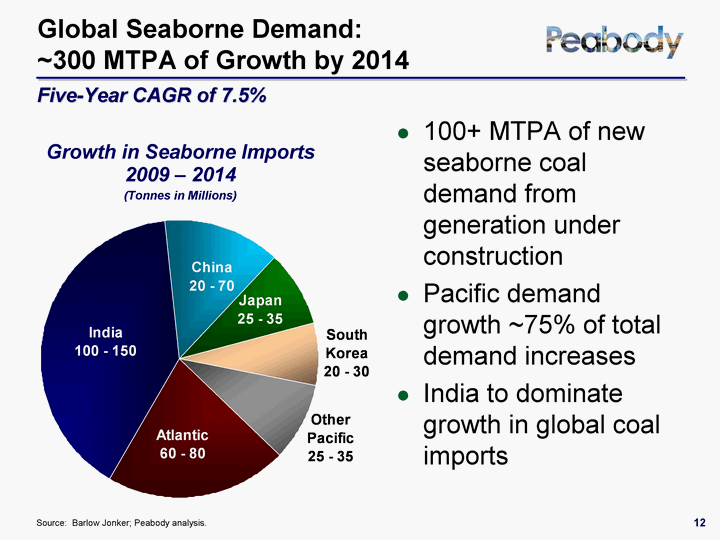
| Global Seaborne Demand: ~300 MTPA of Growth by 2014 Source: Barlow Jonker; Peabody analysis. 100+ MTPA of new seaborne coal demand from generation under construction Pacific demand growth ~75% of total demand increases India to dominate growth in global coal imports India China Japan South Korea Other Pacific Atlantic 132 45 29 24 30 70 Growth in Seaborne Imports 2009 - 2014 (Tonnes in Millions) Five-Year CAGR of 7.5% |
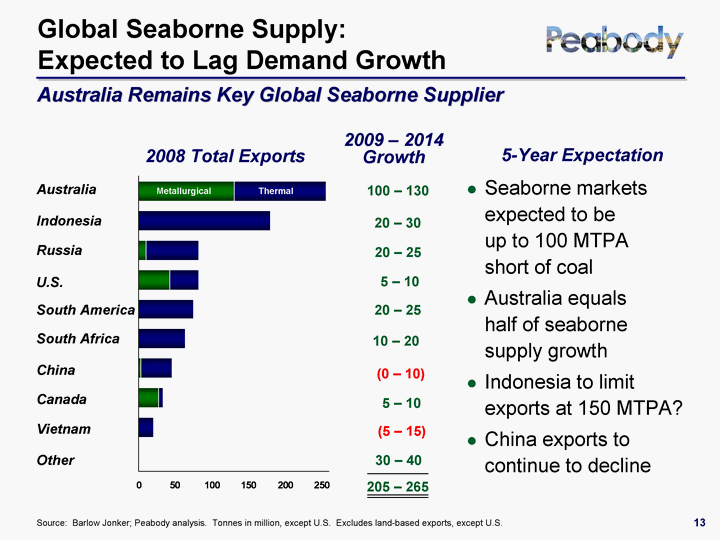
| 30 - 40 Other Vietnam Canada China South Africa South America U.S. Russia Indonesia Australia Metallurgical 0 27 3.5 0 0 42.5 10 0 130 Thermal 20 6 42 64 75 39 72 180 126 2008 Total Exports Global Seaborne Supply: Expected to Lag Demand Growth Source: Barlow Jonker; Peabody analysis. Tonnes in million, except U.S. Excludes land-based exports, except U.S. Metallurgical Thermal U.S. South Africa South America Russia Australia Indonesia Canada China Vietnam Seaborne markets expected to be up to 100 MTPA short of coal Australia equals half of seaborne supply growth Indonesia to limit exports at 150 MTPA? China exports to continue to decline 5-Year Expectation Australia Remains Key Global Seaborne Supplier 100 - 130 2009 - 2014 Growth 20 - 30 20 - 25 20 - 25 10 - 20 5 - 10 (0 - 10) 5 - 10 (5 - 15) Other 205 - 265 |
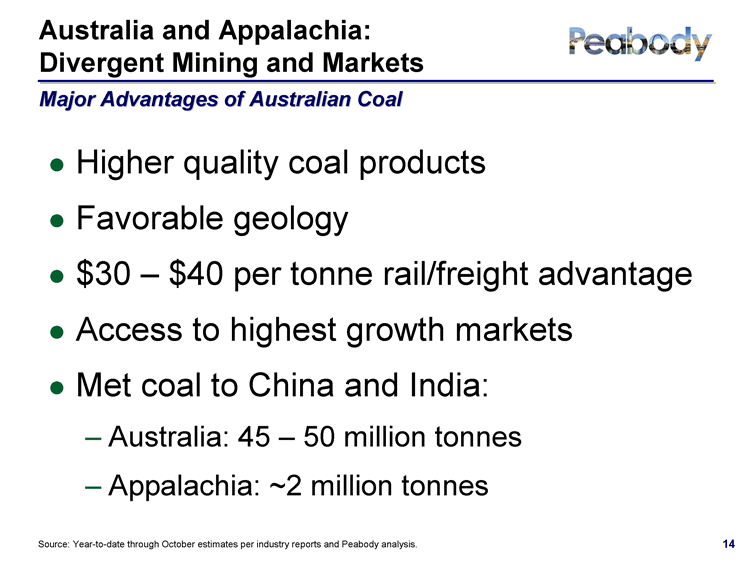
| Australia and Appalachia: Divergent Mining and Markets Higher quality coal products Favorable geology $30 - $40 per tonne rail/freight advantage Access to highest growth markets Met coal to China and India: Australia: 45 - 50 million tonnes Appalachia: ~2 million tonnes Major Advantages of Australian Coal Source: Year-to-date through October estimates per industry reports and Peabody analysis. |
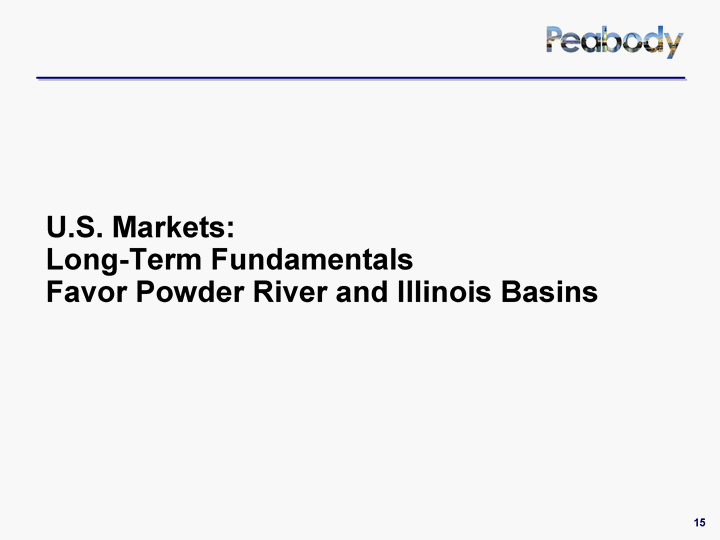
| U.S. Markets: Long-Term Fundamentals Favor Powder River and Illinois Basins |
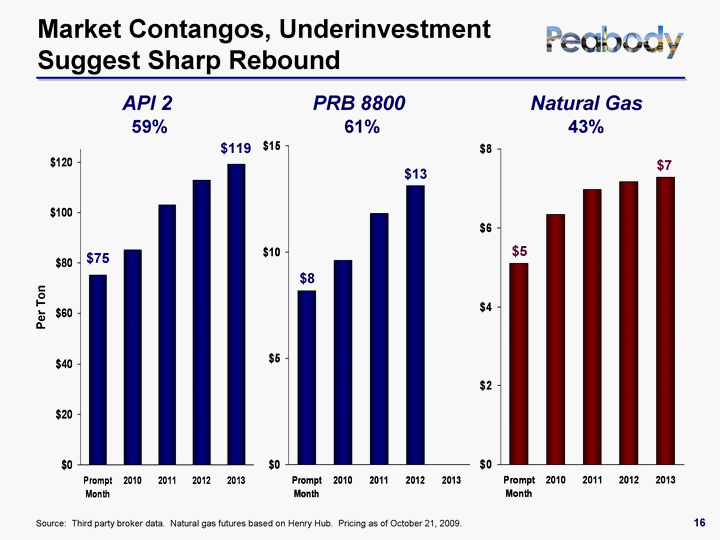
| Prompt Month 2010 2011 2012 2013 75.06 85.19 102.93 112.63 119.17 Prompt Month 2010 2011 2012 2013 8.18 9.61 11.83 13.13 0 Prompt Month 2010 2011 2012 2013 5.1 6.33 6.98 7.17 7.29 Market Contangos, Underinvestment Suggest Sharp Rebound API 2 $119 $75 Source: Third party broker data. Natural gas futures based on Henry Hub. Pricing as of October 21, 2009. Natural Gas PRB 8800 $8 $13 $5 59% 61% 43% $7 Per Ton |
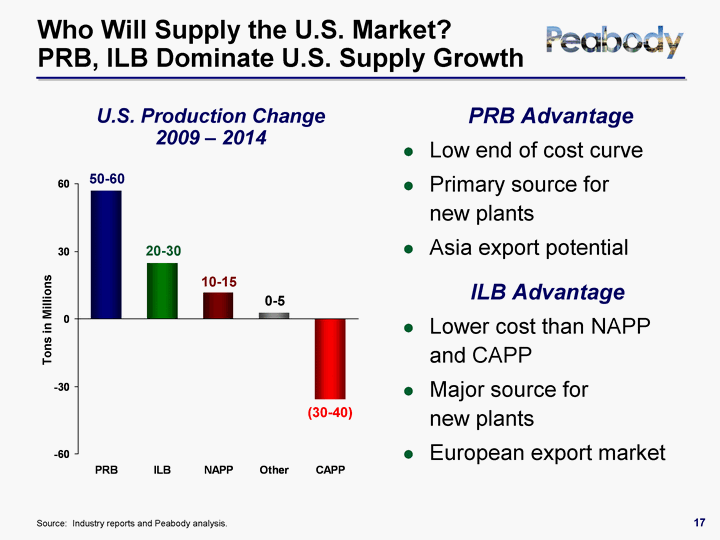
| Who Will Supply the U.S. Market? PRB, ILB Dominate U.S. Supply Growth PRB Advantage Low end of cost curve Primary source for new plants Asia export potential ILB Advantage Lower cost than NAPP and CAPP Major source for new plants European export market PRB ILB NAPP Other CAPP 2009 57 25 12 3 -36 U.S. Production Change 2009 - 2014 50-60 20-30 10-15 0-5 (30-40) Source: Industry reports and Peabody analysis. Tons in Millions |
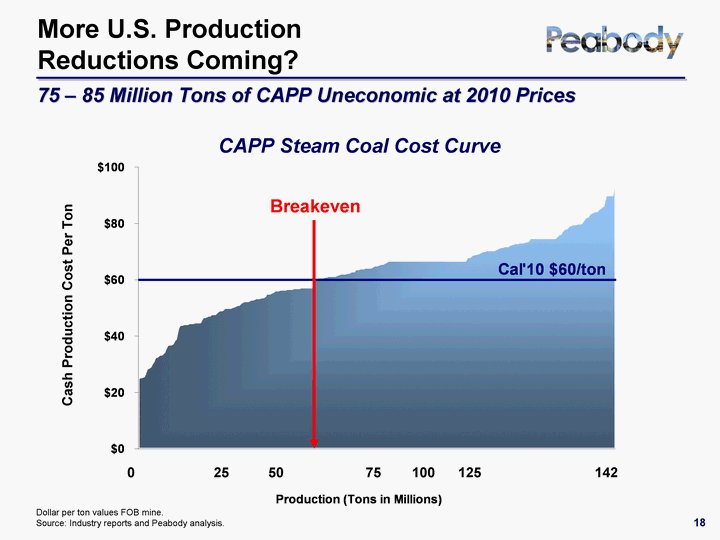
| More U.S. Production Reductions Coming? Dollar per ton values FOB mine. Source: Industry reports and Peabody analysis. 75 - 85 Million Tons of CAPP Uneconomic at 2010 Prices CAPP Steam Coal Cost Curve Breakeven 0 25 0 50 75 100 125 142 Cash Production Cost Per Ton |
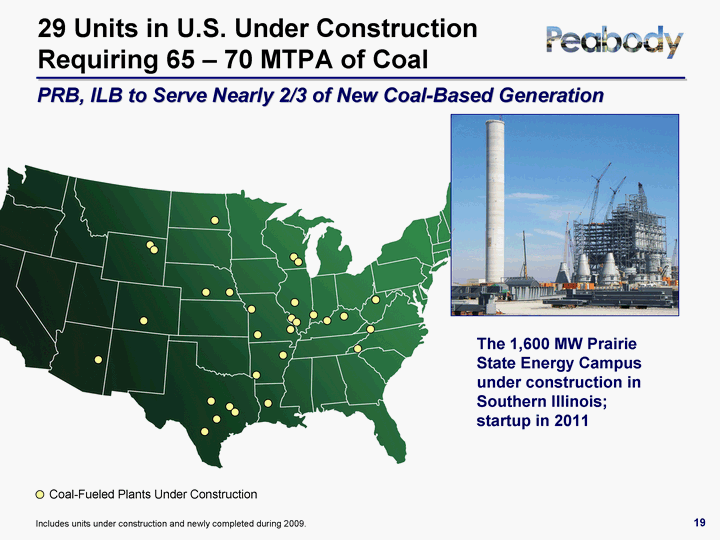
| 29 Units in U.S. Under Construction Requiring 65 - 70 MTPA of Coal Includes units under construction and newly completed during 2009. PRB, ILB to Serve Nearly 2/3 of New Coal-Based Generation The 1,600 MW Prairie State Energy Campus under construction in Southern Illinois; startup in 2011 Coal-Fueled Plants Under Construction |
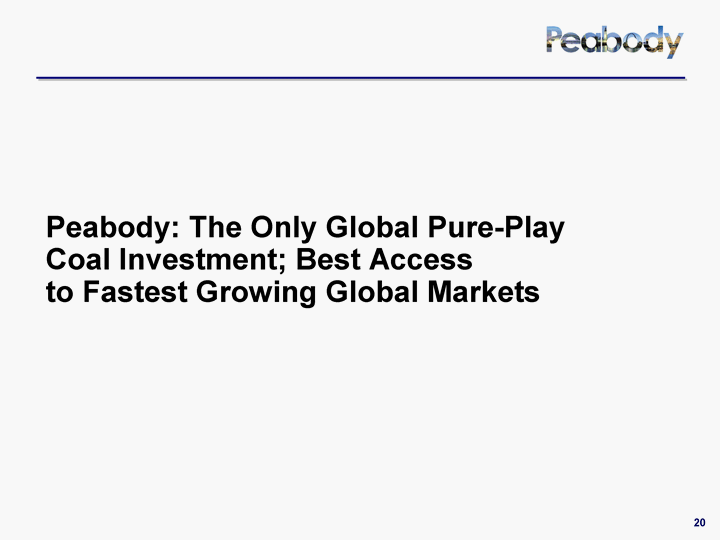
| Peabody: The Only Global Pure-Play Coal Investment; Best Access to Fastest Growing Global Markets |
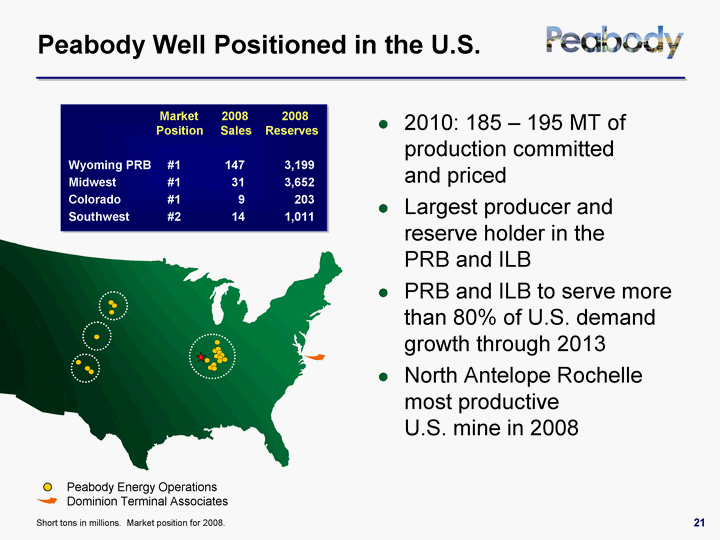
| Peabody Well Positioned in the U.S. Market 2008 2008 Position Sales Reserves Wyoming PRB #1 147 3,199 Midwest #1 31 3,652 Colorado #1 9 203 Southwest #2 14 1,011 2010: 185 - 195 MT of production committed and priced Largest producer and reserve holder in the PRB and ILB PRB and ILB to serve more than 80% of U.S. demand growth through 2013 North Antelope Rochelle most productive U.S. mine in 2008 Short tons in millions. Market position for 2008. Peabody Energy Operations Dominion Terminal Associates |
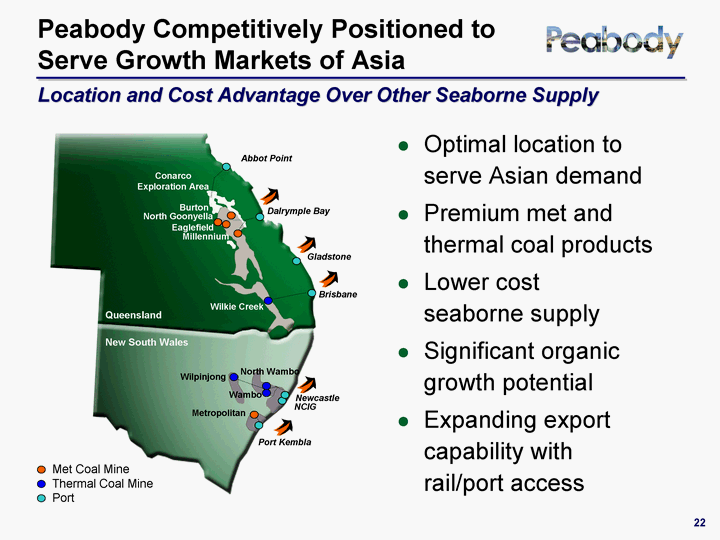
| 22 Location and Cost Advantage Over Other Seaborne Supply Peabody Competitively Positioned to Serve Growth Markets of Asia Optimal location to serve Asian demand Premium met and thermal coal products Lower cost seaborne supply Significant organic growth potential Expanding export capability with rail/port access Burton North Goonyella Eaglefield Millennium Metropolitan Dalrymple Bay Abbot Point Port Kembla Queensland New South Wales Conarco Exploration Area Wilkie Creek Brisbane Wilpinjong North Wambo Wambo NCIG Newcastle Met Coal Mine Thermal Coal Mine Port Gladstone |
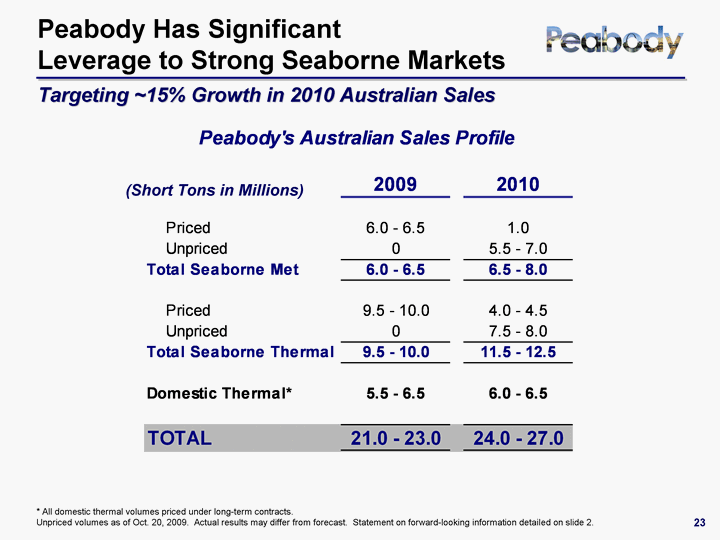
| Peabody Has Significant Leverage to Strong Seaborne Markets Targeting ~15% Growth in 2010 Australian Sales (Short Tons in Millions) * All domestic thermal volumes priced under long-term contracts. Unpriced volumes as of Oct. 20, 2009. Actual results may differ from forecast. Statement on forward-looking information detailed on slide 2. |
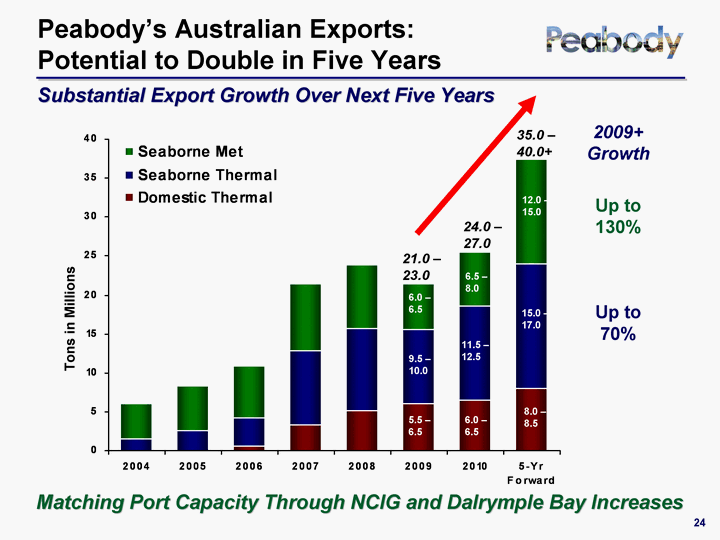
| 2004 2005 2006 2007 2008 2009 2010 5-Yr Forward Domestic Thermal 0 0 0.6 3.3 5.1 6 6.5 8 Seaborne Thermal 1.5 2.5 3.6 9.5 10.6 9.5 12 16 Seaborne Met 4.6 5.8 6.6 8.7 8.16 6 7 13.5 1.5 2.5 2.5 6.0 - 6.5 11.5 - 12.5 6.5 - 8.0 5.5 - 6.5 9.5 - 10.0 6.0 - 6.5 8.0 - 8.5 15.0 - 17.0 12.0 - 15.0 21.0 - 23.0 24.0 - 27.0 35.0 - 40.0+ Substantial Export Growth Over Next Five Years Peabody's Australian Exports: Potential to Double in Five Years Up to 130% Up to 70% 2009+ Growth Tons in Millions Matching Port Capacity Through NCIG and Dalrymple Bay Increases |
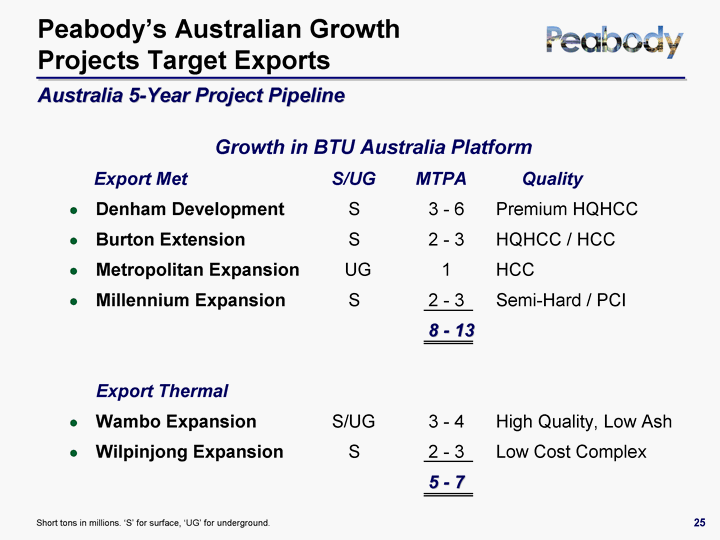
| Australia 5-Year Project Pipeline Peabody's Australian Growth Projects Target Exports Growth in BTU Australia Platform Export Met S/UG MTPA Quality Denham Development S 3 - 6 Premium HQHCC Burton Extension S 2 - 3 HQHCC / HCC Metropolitan Expansion UG 1 HCC Millennium Expansion S 2 - 3 Semi-Hard / PCI 8 - 13 Export Thermal Wambo Expansion S/UG 3 - 4 High Quality, Low Ash Wilpinjong Expansion S 2 - 3 Low Cost Complex 5 - 7 Short tons in millions. 'S' for surface, 'UG' for underground. |
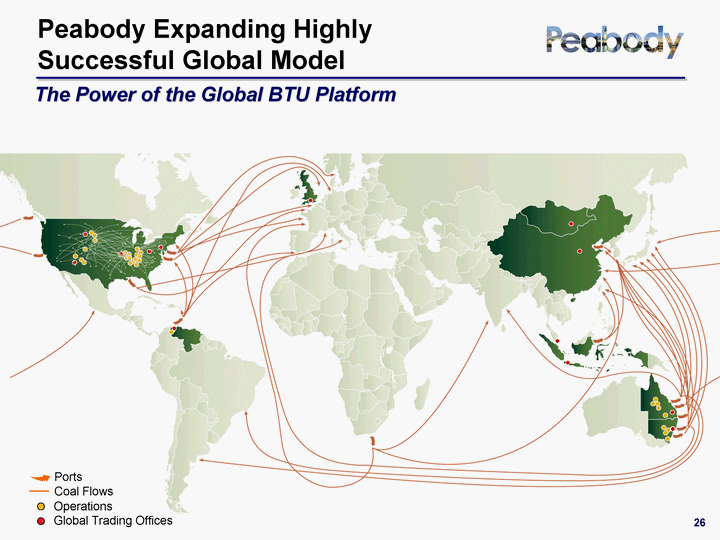
| 26 26 Operations Global Trading Offices Peabody Expanding Highly Successful Global Model The Power of the Global BTU Platform Ports Coal Flows |
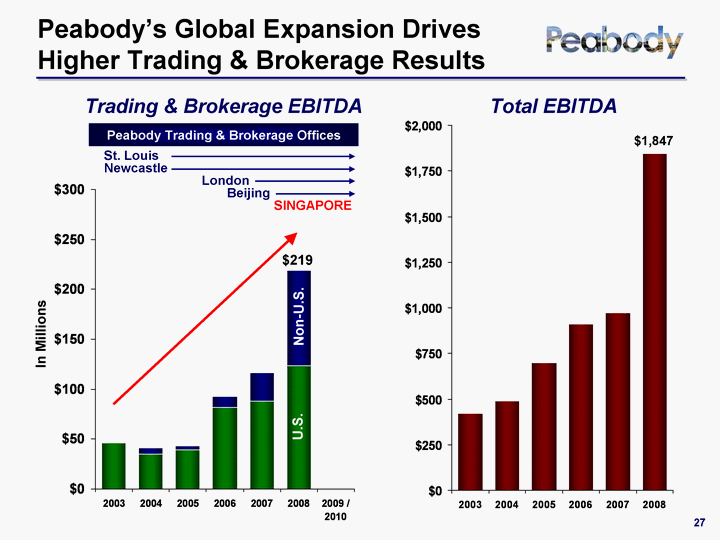
| 2003 2004 2005 2006 2007 2008 2009 / 2010 Domestic EBITDA 45.828 34.781 38.745 81.604 87.781 123.683 International EBITDA 0 6.258 4.313 11 28.819 95.217 St. Louis Newcastle London Beijing SINGAPORE Peabody's Global Expansion Drives Higher Trading & Brokerage Results 2003 2004 2005 2006 2007 2008 Domestic EBITDA 422 490 696.4 909.7 969.7 1846.9 Trading & Brokerage EBITDA Total EBITDA U.S. Non-U.S. $1,847 Peabody Trading & Brokerage Offices $219 In Millions |
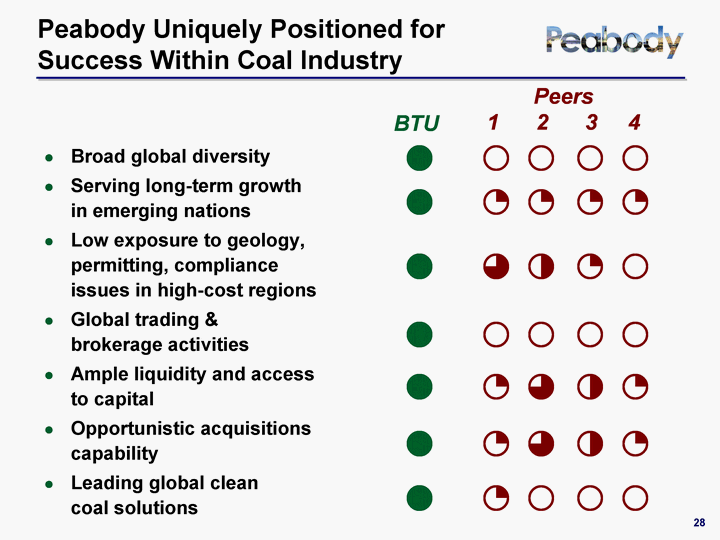
| Peabody Uniquely Positioned for Success Within Coal Industry Broad global diversity Serving long-term growth in emerging nations Low exposure to geology, permitting, compliance issues in high-cost regions Global trading & brokerage activities Ample liquidity and access to capital Opportunistic acquisitions capability Leading global clean coal solutions 28 |
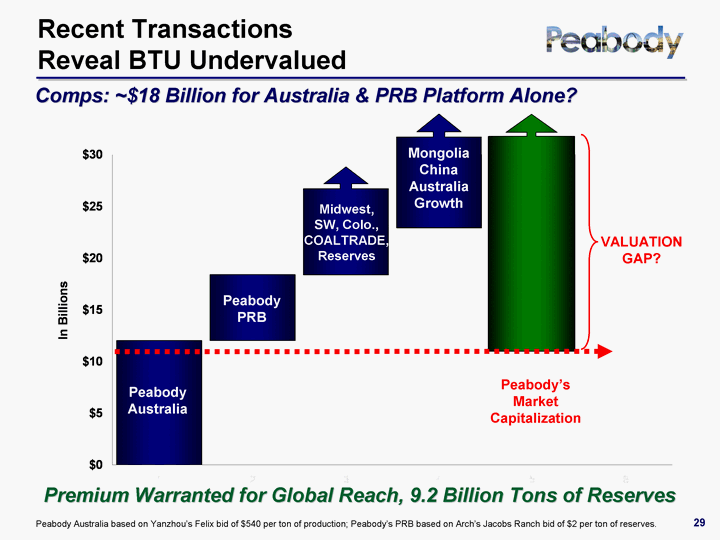
| Recent Transactions Reveal BTU Undervalued Comps: ~$18 Billion for Australia & PRB Platform Alone? Peabody Australia Peabody PRB Peabody's Market Capitalization VALUATION GAP? Mongolia China Australia Growth Midwest, SW, Colo., COALTRADE, Reserves Peabody Australia based on Yanzhou's Felix bid of $540 per ton of production; Peabody's PRB based on Arch's Jacobs Ranch bid of $2 per ton of reserves. 29 Premium Warranted for Global Reach, 9.2 Billion Tons of Reserves |
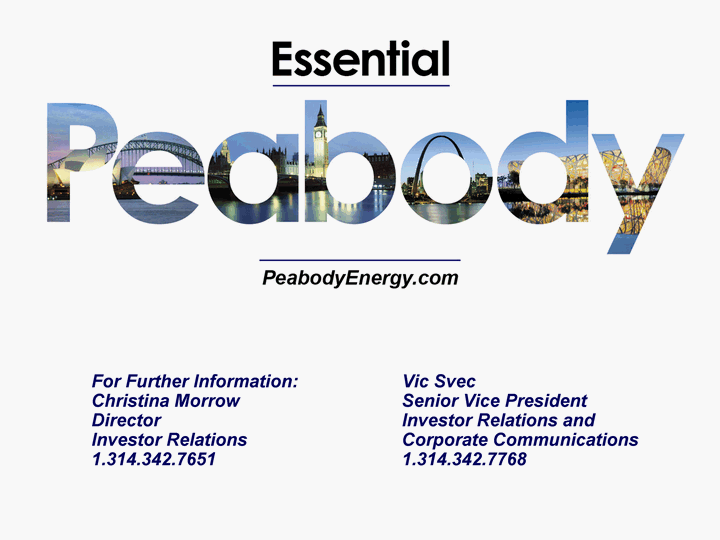
| For Further Information: Christina Morrow Director Investor Relations 1.314.342.7651 Vic Svec Senior Vice President Investor Relations and Corporate Communications 1.314.342.7768 |
